Comprehensive Transcriptome Analysis Reveals Sex-Specific Alternative Splicing Events in Zebrafish Gonads
Abstract
1. Introduction
2. Materials and Methods
2.1. Fish Maintenance
2.2. Collection of RNA-Seq Data
2.3. Differential Gene Expression Analysis and Enrichment Analysis
2.4. Differential AS Analysis and Validation
2.5. Splice Site Scoring, GC Content and Length Calculating
2.6. Protein–Protein Interaction (PPI)
2.7. Three-Dimensional Protein Structure Prediction and Analysis
2.8. Statistical Analysis and Data Visualization
3. Results
3.1. Identification of gDEGs and gDASGs between Zebrafish Ovaries and Testes Based on RNA-Seq Data
3.2. Classification and Validation of the Gonad-Specific AS Events
3.3. Sequence Characteristics of the AS Exons and Introns in Ovaries and Testes
3.4. Ovary-Specific Constituent Exons Are Associated with Microtubule Function
3.5. Determining the Possible Consequence of a Sex-Specific AS Event on the Function of ncoa5 Gene by Conservation and 3D Structure Analysis
4. Discussion
5. Conclusions
Supplementary Materials
Author Contributions
Funding
Institutional Review Board Statement
Informed Consent Statement
Data Availability Statement
Conflicts of Interest
References
- Jiang, H.; Lin, J.Q.; Sun, L.; Xu, Y.C.; Fang, S.G. Sex-Biased Gene Expression and Evolution in the Cerebrum and Syrinx of Chinese Hwamei (Garrulax canorus). Genes 2021, 12, 569. [Google Scholar] [CrossRef] [PubMed]
- Lewis, Z.; Wedell, N.; Hunt, J. Evidence for strong intralocus sexual conflict in the Indian meal moth, Plodia interpunctella. Evolution 2011, 65, 2085–2097. [Google Scholar] [CrossRef]
- Ghiselli, F.; Iannello, M.; Puccio, G.; Chang, P.L.; Plazzi, F.; Nuzhdin, S.V.; Passamonti, M. Comparative Transcriptomics in Two Bivalve Species Offers Different Perspectives on the Evolution of Sex-Biased Genes. Genome Biol. Evol. 2018, 10, 1389–1402. [Google Scholar] [CrossRef]
- Wang, P.; Zheng, M.; Liu, J.; Liu, Y.; Lu, J.; Sun, X. Sexually Dimorphic Gene Expression Associated with Growth and Reproduction of Tongue Sole (Cynoglossus semilaevis) Revealed by Brain Transcriptome Analysis. Int. J. Mol. Sci. 2016, 17, 1402. [Google Scholar] [CrossRef]
- Connallon, T.; Knowles, L.L. Intergenomic conflict revealed by patterns of sex-biased gene expression. Trends Genet. 2005, 21, 495–499. [Google Scholar] [CrossRef] [PubMed]
- Parisi, M.; Nuttall, R.; Edwards, P.; Minor, J.; Naiman, D.; Lu, J.N.; Doctolero, M.; Vainer, M.; Chan, C.; Malley, J.; et al. A survey of ovary-, testis-, and soma-biased gene expression in Drosophila melanogaster adults. Genome Biol. 2004, 5, R40. [Google Scholar] [CrossRef] [PubMed]
- Small, C.L.; Shima, J.E.; Uzumcu, M.; Skinner, M.K.; Griswold, M.D. Profiling gene expression during the differentiation and development of the murine embryonic gonad. Biol. Reprod. 2005, 72, 492–501. [Google Scholar] [CrossRef]
- Li, Y.; Chen, Z.; Liu, H.; Li, Q.; Lin, X.; Ji, S.; Li, R.; Li, S.; Fan, W.; Zhao, H.; et al. ASER: Animal sex reversal database. Genom. Proteom. Bioinf. 2021, 19, 873–881. [Google Scholar] [CrossRef]
- Planells, B.; Gomez-Redondo, I.; Pericuesta, E.; Lonergan, P.; Gutierrez-Adan, A. Differential isoform expression and alternative splicing in sex determination in mice. BMC Genom. 2019, 20, 202. [Google Scholar] [CrossRef]
- Mayshar, Y.; Rom, E.; Chumakov, I.; Kronman, A.; Yayon, A.; Benvenisty, N. Fibroblast growth factor 4 and its novel splice isoform have opposing effects on the maintenance of human embryonic stem cell self-renewal. Stem Cells 2008, 26, 767–774. [Google Scholar] [CrossRef]
- Wang, E.T.; Sandberg, R.; Luo, S.; Khrebtukova, I.; Zhang, L.; Mayr, C.; Kingsmore, S.F.; Schroth, G.P.; Burge, C.B. Alternative isoform regulation in human tissue transcriptomes. Nature 2008, 456, 470–476. [Google Scholar] [CrossRef] [PubMed]
- Gomez-Redondo, I.; Planells, B.; Navarrete, P.; Gutierrez-Adan, A. Role of Alternative Splicing in Sex Determination in Vertebrates. Sex. Dev. 2021, 15, 381–391. [Google Scholar] [CrossRef]
- Zhang, X.; Wagner, S.; Holleley, C.E.; Deakin, J.E.; Matsubara, K.; Deveson, I.W.; O’Meally, D.; Patel, H.R.; Ezaz, T.; Li, Z.; et al. Sex-specific splicing of Z- and W-borne nr5a1 alleles suggests sex determination is controlled by chromosome conformation. Proc. Natl. Acad. Sci. USA 2022, 119, e2116475119. [Google Scholar] [CrossRef] [PubMed]
- Krovel, A.V.; Olsen, L.C. Sexual dimorphic expression pattern of a splice variant of zebrafish vasa during gonadal development. Dev. Biol. 2004, 271, 190–197. [Google Scholar] [CrossRef][Green Version]
- Ye, M.; Chen, Y. Zebrafish as an emerging model to study gonad development. Comput. Struct. Biotechnol. J. 2020, 18, 2373–2380. [Google Scholar] [CrossRef] [PubMed]
- Kossack, M.E.; Draper, B.W. Genetic regulation of sex determination and maintenance in zebrafish (Danio rerio). Curr. Top. Dev. Biol. 2019, 134, 119–149. [Google Scholar] [CrossRef] [PubMed]
- Kettleborough, R.N.; Busch-Nentwich, E.M.; Harvey, S.A.; Dooley, C.M.; de Bruijn, E.; van Eeden, F.; Sealy, I.; White, R.J.; Herd, C.; Nijman, I.J.; et al. A systematic genome-wide analysis of zebrafish protein-coding gene function. Nature 2013, 496, 494–497. [Google Scholar] [CrossRef]
- Liu, F.; Chen, J.; Yu, S.; Raghupathy, R.K.; Liu, X.; Qin, Y.; Li, C.; Huang, M.; Liao, S.; Wang, J.; et al. Knockout of RP2 decreases GRK1 and rod transducin subunits and leads to photoreceptor degeneration in zebrafish. Hum. Mol. Genet. 2015, 24, 4648–4659. [Google Scholar] [CrossRef][Green Version]
- Chen, L.; Wang, L.; Cheng, Q.; Tu, Y.X.; Yang, Z.; Li, R.Z.; Luo, Z.H.; Chen, Z.X. Anti-masculinization induced by aromatase inhibitors in adult female zebrafish. BMC Genom. 2020, 21, 22. [Google Scholar] [CrossRef]
- Herberg, S.; Gert, K.R.; Schleiffer, A.; Pauli, A. The Ly6/uPAR protein Bouncer is necessary and sufficient for species-specific fertilization. Science 2018, 361, 1029–1033. [Google Scholar] [CrossRef]
- Fujihara, Y.; Herberg, S.; Blaha, A.; Panser, K.; Kobayashi, K.; Larasati, T.; Novatchkova, M.; Theussl, H.C.; Olszanska, O.; Ikawa, M.; et al. The conserved fertility factor SPACA4/Bouncer has divergent modes of action in vertebrate fertilization. Proc. Natl. Acad. Sci. USA 2021, 118, e2108777118. [Google Scholar] [CrossRef] [PubMed]
- Bai, J.; Yang, Z.Z.; Li, H.; Hong, Y.; Fan, D.D.; Lin, A.F.; Xiang, L.X.; Shao, J.Z. Genome-Wide Characterization of Zebrafish Endogenous Retroviruses Reveals Unexpected Diversity in Genetic Organizations and Functional Potentials. Microbiol. Spectr. 2021, 9, e0225421. [Google Scholar] [CrossRef] [PubMed]
- Bolger, A.M.; Lohse, M.; Usadel, B. Trimmomatic: A flexible trimmer for Illumina sequence data. Bioinformatics 2014, 30, 2114–2120. [Google Scholar] [CrossRef] [PubMed]
- Dobin, A.; Davis, C.A.; Schlesinger, F.; Drenkow, J.; Zaleski, C.; Jha, S.; Batut, P.; Chaisson, M.; Gingeras, T.R. STAR: Ultrafast universal RNA-seq aligner. Bioinformatics 2013, 29, 15–21. [Google Scholar] [CrossRef]
- Liao, Y.; Smyth, G.K.; Shi, W. featureCounts: An efficient general purpose program for assigning sequence reads to genomic features. Bioinformatics 2014, 30, 923–930. [Google Scholar] [CrossRef]
- Love, M.I.; Huber, W.; Anders, S. Moderated estimation of fold change and dispersion for RNA-seq data with DESeq2. Genome Biol. 2014, 15, 550. [Google Scholar] [CrossRef]
- Young, M.D.; Wakefield, M.J.; Smyth, G.K.; Oshlack, A. Gene ontology analysis for RNA-seq: Accounting for selection bias. Genome Biol. 2010, 11, R14. [Google Scholar] [CrossRef]
- Yu, G.C.; Wang, L.G.; Han, Y.Y.; He, Q.Y. clusterProfiler: An R Package for Comparing Biological Themes among Gene Clusters. Omics J. Integr. Biol. 2012, 16, 284–287. [Google Scholar] [CrossRef]
- Shen, S.H.; Park, J.W.; Lu, Z.X.; Lin, L.; Henry, M.D.; Wu, Y.N.; Zhou, Q.; Xing, Y. rMATS: Robust and flexible detection of differential alternative splicing from replicate RNA-Seq data. Proc. Natl. Acad. Sci. USA 2014, 111, E5593–E5601. [Google Scholar] [CrossRef]
- Thorvaldsdottir, H.; Robinson, J.T.; Mesirov, J.P. Integrative Genomics Viewer (IGV): High-performance genomics data visualization and exploration. Brief. Bioinform. 2013, 14, 178–192. [Google Scholar] [CrossRef]
- Yeo, G.; Burge, C.B. Maximum entropy modeling of short sequence motifs with applications to RNA splicing signals. J. Comput. Biol. 2004, 11, 377–394. [Google Scholar] [CrossRef]
- Quinlan, A.R.; Hall, I.M. BEDTools: A flexible suite of utilities for comparing genomic features. Bioinformatics 2010, 26, 841–842. [Google Scholar] [CrossRef]
- Szklarczyk, D.; Gable, A.L.; Lyon, D.; Junge, A.; Wyder, S.; Huerta-Cepas, J.; Simonovic, M.; Doncheva, N.T.; Morris, J.H.; Bork, P.; et al. STRING v11: Protein-protein association networks with increased coverage, supporting functional discovery in genome-wide experimental datasets. Nucleic Acids Res. 2019, 47, D607–D613. [Google Scholar] [CrossRef]
- Jumper, J.; Evans, R.; Pritzel, A.; Green, T.; Figurnov, M.; Ronneberger, O.; Tunyasuvunakool, K.; Bates, R.; Zidek, A.; Potapenko, A.; et al. Highly accurate protein structure prediction with AlphaFold. Nature 2021, 596, 583–589. [Google Scholar] [CrossRef]
- Jin, Z.L.; Suk, N.; Kim, N.H. TP53BP1 regulates chromosome alignment and spindle bipolarity in mouse oocytes. Mol. Reprod. Dev. 2019, 86, 1126–1137. [Google Scholar] [CrossRef]
- Neumayer, G.; Belzil, C.; Gruss, O.J.; Nguyen, M.D. TPX2: Of spindle assembly, DNA damage response, and cancer. Cell. Mol. Life Sci. 2014, 71, 3027–3047. [Google Scholar] [CrossRef]
- Dai, X.Y.; Cheng, X.K.; Huang, J.F.; Gao, Y.P.; Wang, D.S.; Feng, Z.; Zhai, G.; Lou, Q.Y.; He, J.Y.; Wang, Z.J.; et al. Rbm46, a novel germ cell-specific factor, modulates meiotic progression and spermatogenesis. Biol. Reprod. 2021, 104, 1139–1153. [Google Scholar] [CrossRef]
- Cartegni, L.; Chew, S.L.; Krainer, A.R. Listening to silence and understanding nonsense: Exonic mutations that affect splicing. Nat. Rev. Genet. 2002, 3, 285–298. [Google Scholar] [CrossRef]
- Tang, L.T.; Ran, X.Q.; Mao, N.; Zhang, F.P.; Niu, X.; Ruan, Y.Q.; Yi, F.L.; Li, S.; Wang, J.F. Analysis of alternative splicing events by RNA sequencing in the ovaries of Xiang pig at estrous and diestrous. Theriogenology 2018, 119, 60–68. [Google Scholar] [CrossRef]
- Gan, Q.; Chepelev, I.; Wei, G.; Tarayrah, L.; Cui, K.; Zhao, K.; Chen, X. Dynamic regulation of alternative splicing and chromatin structure in Drosophila gonads revealed by RNA-seq. Cell Res. 2010, 20, 763–783. [Google Scholar] [CrossRef]
- Resch, A.; Xing, Y.; Alekseyenko, A.; Modrek, B.; Lee, C. Evidence for a subpopulation of conserved alternative splicing events under selection pressure for protein reading frame preservation. Nucleic Acids Res. 2004, 32, 1261–1269. [Google Scholar] [CrossRef]
- Sorek, R.; Shamir, R.; Ast, G. How prevalent is functional alternative splicing in the human genome? Trends Genet. 2004, 20, 68–71. [Google Scholar] [CrossRef]
- O’Connor, B.P.; Danhorn, T.; De Arras, L.; Flatley, B.R.; Marcus, R.A.; Farias-Hesson, E.; Leach, S.M.; Alper, S. Regulation of toll-like receptor signaling by the SF3a mRNA splicing complex. PLoS Genet. 2015, 11, e1004932. [Google Scholar] [CrossRef]
- Ramalho, R.F.; Li, S.; Radivojac, P.; Hahn, M.W. Proteomic Evidence for In-Frame and Out-of-Frame Alternatively Spliced Isoforms in Human and Mouse. IEEE ACM Trans. Comput. Biol. Bioinform. 2018, 15, 1284–1289. [Google Scholar] [CrossRef]
- Miles, C.; Elgar, G.; Coles, E.; Kleinjan, D.J.; van Heyningen, V.; Hastie, N. Complete sequencing of the Fugu WAGR region from WT1 to PAX6: Dramatic compaction and conservation of synteny with human chromosome 11p13. Proc. Natl. Acad. Sci. USA 1998, 95, 13068–13072. [Google Scholar] [CrossRef]
- Hammes, A.; Guo, J.K.; Lutsch, G.; Leheste, J.R.; Landrock, D.; Ziegler, U.; Gubler, M.C.; Schedl, A. Two splice variants of the Wilms’ tumor 1 gene have distinct functions during sex determination and nephron formation. Cell 2001, 106, 319–329. [Google Scholar] [CrossRef]
- Wilhelm, D.; Englert, C. The Wilms tumor suppressor WT1 regulates early gonad development by activation of Sf1. Genes Dev. 2002, 16, 1839–1851. [Google Scholar] [CrossRef]
- Ye, Z.; Chen, Z.; Lan, X.; Hara, S.; Sunkel, B.; Huang, T.H.; Elnitski, L.; Wang, Q.; Jin, V.X. Computational analysis reveals a correlation of exon-skipping events with splicing, transcription and epigenetic factors. Nucleic Acids Res. 2014, 42, 2856–2869. [Google Scholar] [CrossRef][Green Version]
- Zhang, Y.; Wu, X.; Li, J.; Sun, K.; Li, H.; Yan, L.; Duan, C.; Liu, H.; Chen, K.; Ye, Z.; et al. Comprehensive characterization of alternative splicing in renal cell carcinoma. Brief. Bioinform. 2021, 22, bbab084. [Google Scholar] [CrossRef]
- Amit, M.; Donyo, M.; Hollander, D.; Goren, A.; Kim, E.; Gelfman, S.; Lev-Maor, G.; Burstein, D.; Schwartz, S.; Postolsky, B.; et al. Differential GC content between exons and introns establishes distinct strategies of splice-site recognition. Cell Rep. 2012, 1, 543–556. [Google Scholar] [CrossRef]
- Yoshimoto, R.; Kaida, D.; Furuno, M.; Burroughs, A.M.; Noma, S.; Suzuki, H.; Kawamura, Y.; Hayashizaki, Y.; Mayeda, A.; Yoshida, M. Global analysis of pre-mRNA subcellular localization following splicing inhibition by spliceostatin A. RNA 2017, 23, 47–57. [Google Scholar] [CrossRef]
- Yamanaka, Y.; Ishizuka, T.; Fujita, K.I.; Fujiwara, N.; Kurata, M.; Masuda, S. CHERP Regulates the Alternative Splicing of pre-mRNAs in the Nucleus. Int. J. Mol. Sci. 2022, 23, 2555. [Google Scholar] [CrossRef]
- Keren, H.; Lev-Maor, G.; Ast, G. Alternative splicing and evolution: Diversification, exon definition and function. Nat. Rev. Genet. 2010, 11, 345–355. [Google Scholar] [CrossRef]
- Liu, Y.; Bourgeois, C.F.; Pang, S.; Kudla, M.; Dreumont, N.; Kister, L.; Sun, Y.H.; Stevenin, J.; Elliott, D.J. The germ cell nuclear proteins hnRNP G-T and RBMY activate a testis-specific exon. PLoS Genet. 2009, 5, e1000707. [Google Scholar] [CrossRef]
- Xu, Q.; Modrek, B.; Lee, C. Genome-wide detection of tissue-specific alternative splicing in the human transcriptome. Nucleic Acids Res. 2002, 30, 3754–3766. [Google Scholar] [CrossRef]
- Boutz, P.L.; Stoilov, P.; Li, Q.; Lin, C.H.; Chawla, G.; Ostrow, K.; Shiue, L.; Ares, M., Jr.; Black, D.L. A post-transcriptional regulatory switch in polypyrimidine tract-binding proteins reprograms alternative splicing in developing neurons. Genes Dev. 2007, 21, 1636–1652. [Google Scholar] [CrossRef] [PubMed]
- Dreumont, N.; Bourgeois, C.F.; Lejeune, F.; Liu, Y.; Ehrmann, I.E.; Elliott, D.J.; Stevenin, J. Human RBMY regulates germline-specific splicing events by modulating the function of the serine/arginine-rich proteins 9G8 and Tra2-β. J. Cell Sci. 2010, 123, 40–50. [Google Scholar] [CrossRef]
- Schoen, J.; Sharbati, S.; Ritter, J.; Jewgenow, K. Feline gonads exhibit tissue specific alternative splicing of oestrogen receptor alpha (ESR1). Reprod. Domest. Anim. Zuchthyg. 2012, 47 (Suppl. 6), 30–34. [Google Scholar] [CrossRef]
- Rustemoglu, A.; Inal, E.E.; Inanir, A.; Ekinci, D.; Gul, U.; Yigit, S.; Ates, O.; Karakus, N. Clinical significance of ncoa5 gene rs2903908 polymorphism in behcet’s disease. EXCLI J. 2017, 16, 609–617. [Google Scholar] [CrossRef]
- Nie, J.; Wang, H.; He, F.; Huang, H. Nusap1 is essential for neural crest cell migration in zebrafish. Protein Cell 2010, 1, 259–266. [Google Scholar] [CrossRef][Green Version]
- Sperry, A.O. The dynamic cytoskeleton of the developing male germ cell. Biol. Cell 2012, 104, 297–305. [Google Scholar] [CrossRef] [PubMed]
- Liu, J.; Lessman, C.A. Soluble tubulin complexes, gamma-tubulin, and their changing distribution in the zebrafish (Danio rerio) ovary, oocyte and embryo. Comp. Biochem. Physiol. Part B Biochem. Mol. Biol. 2007, 147, 56–73. [Google Scholar] [CrossRef] [PubMed]
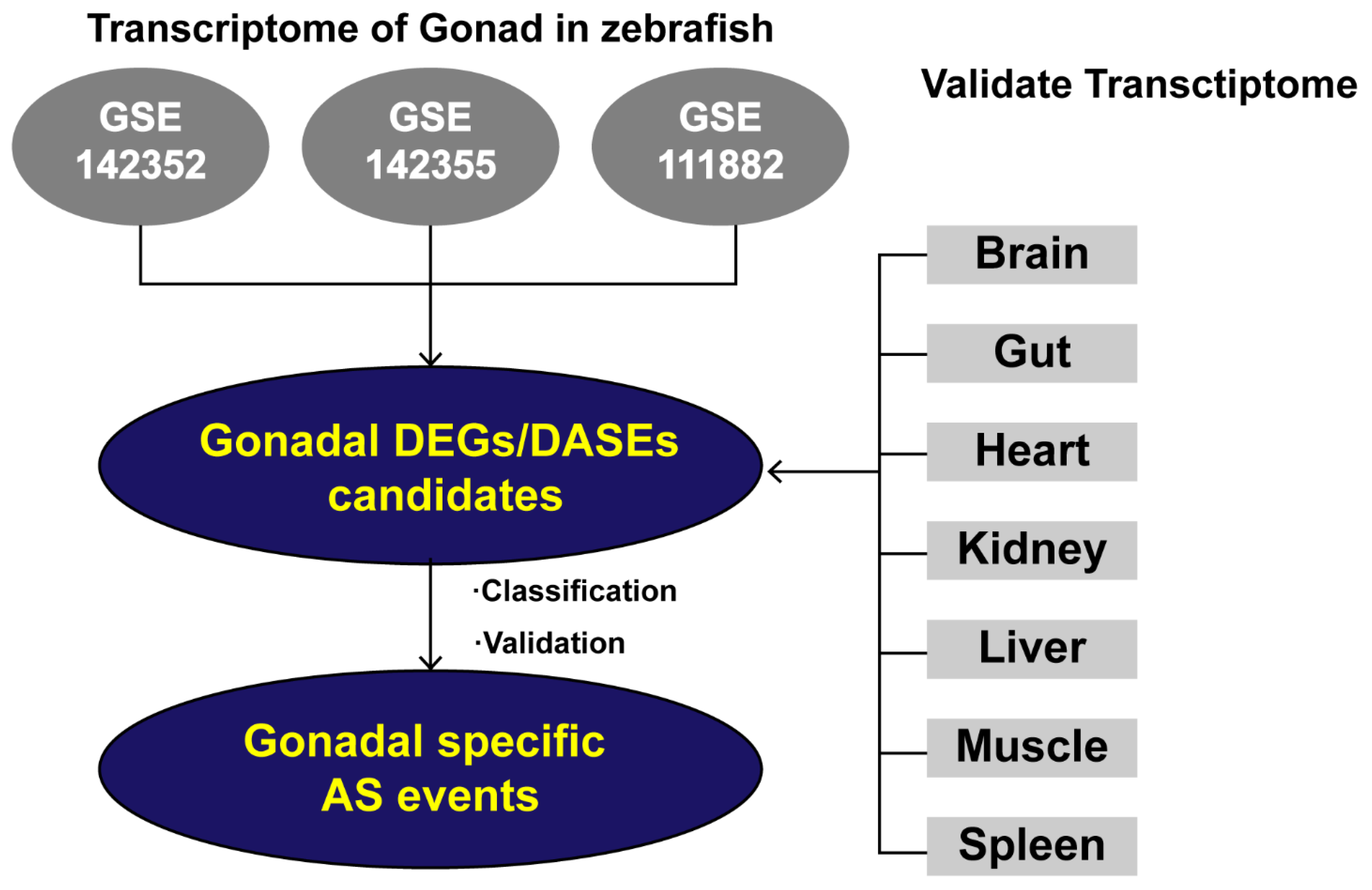
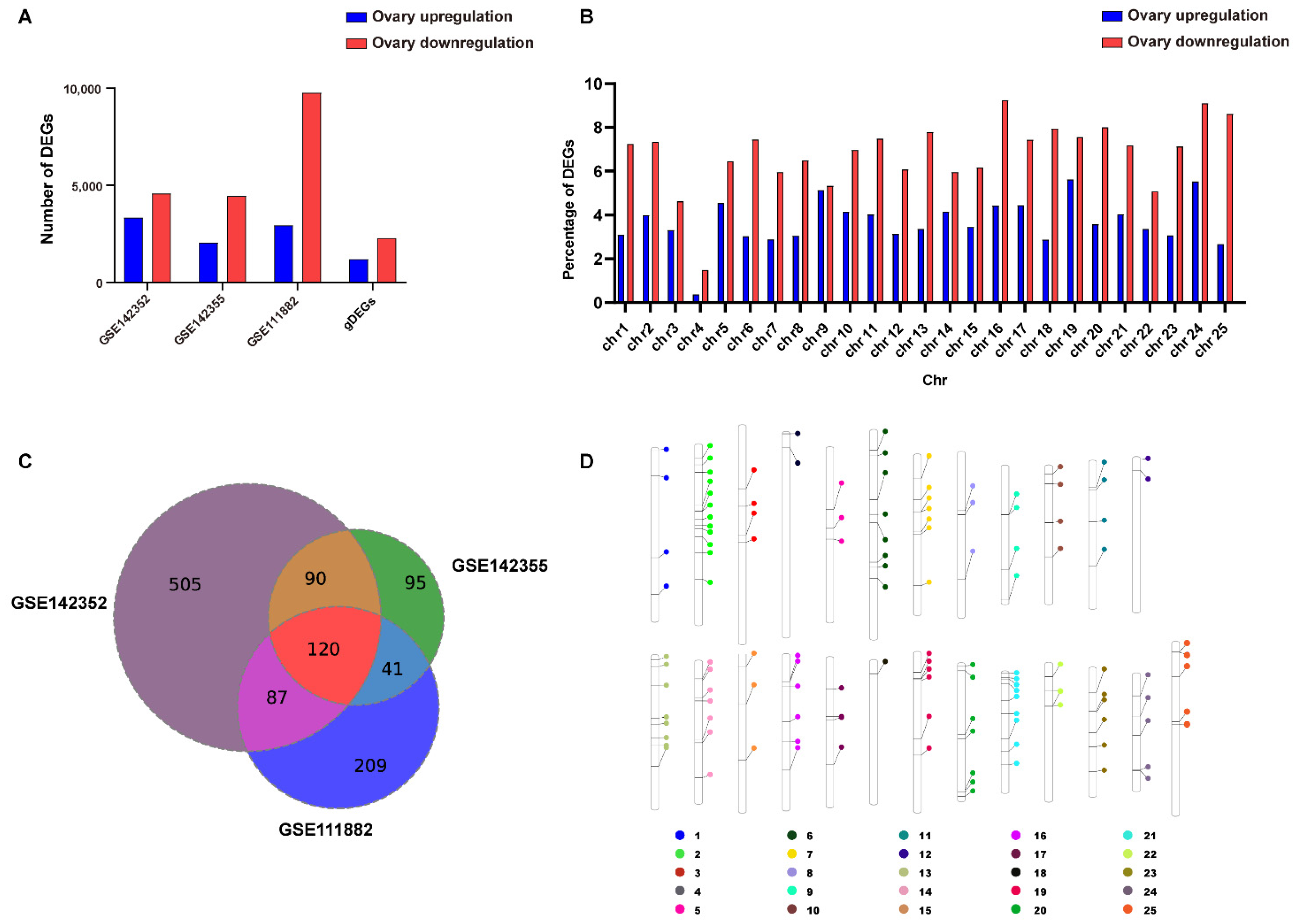
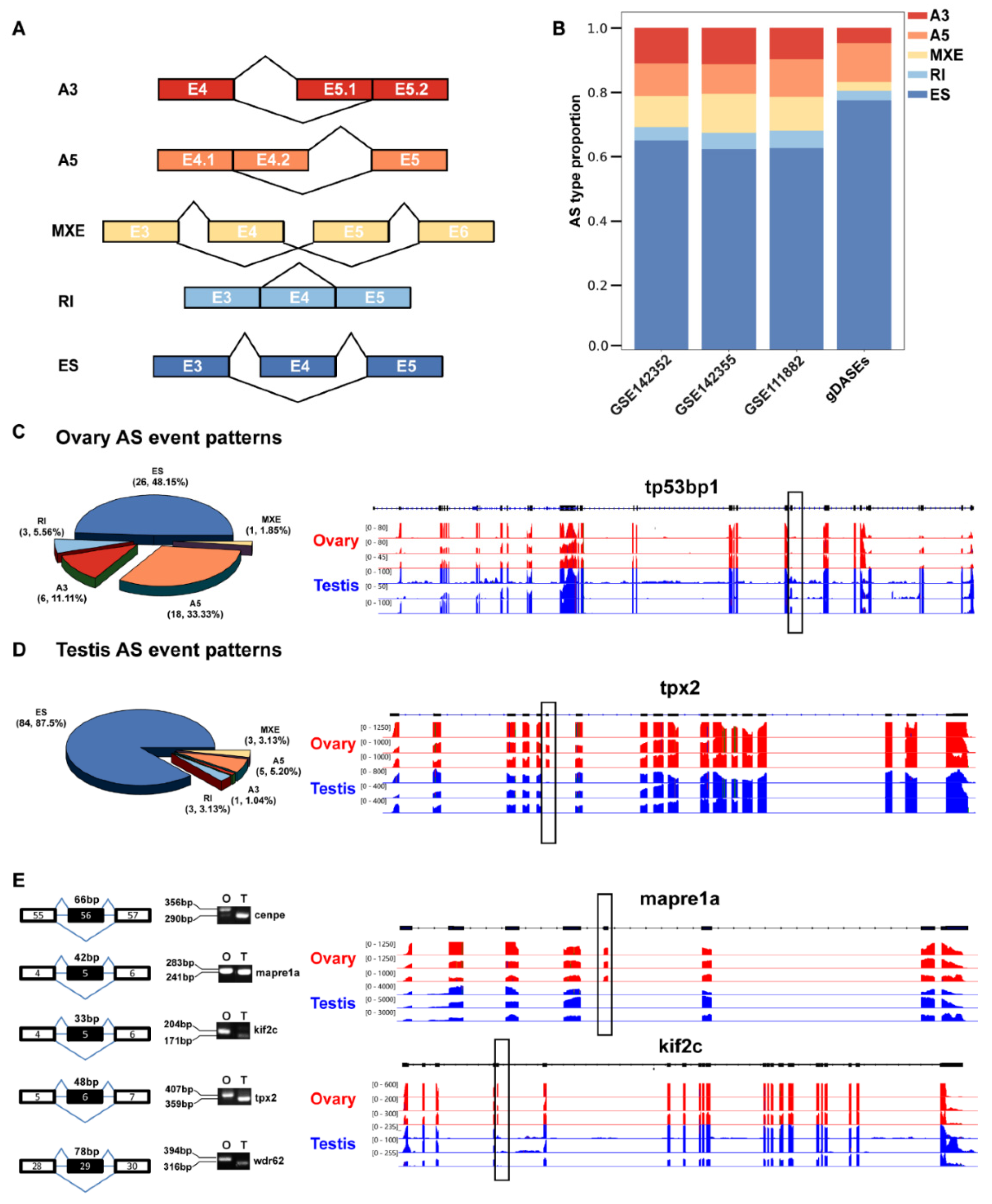
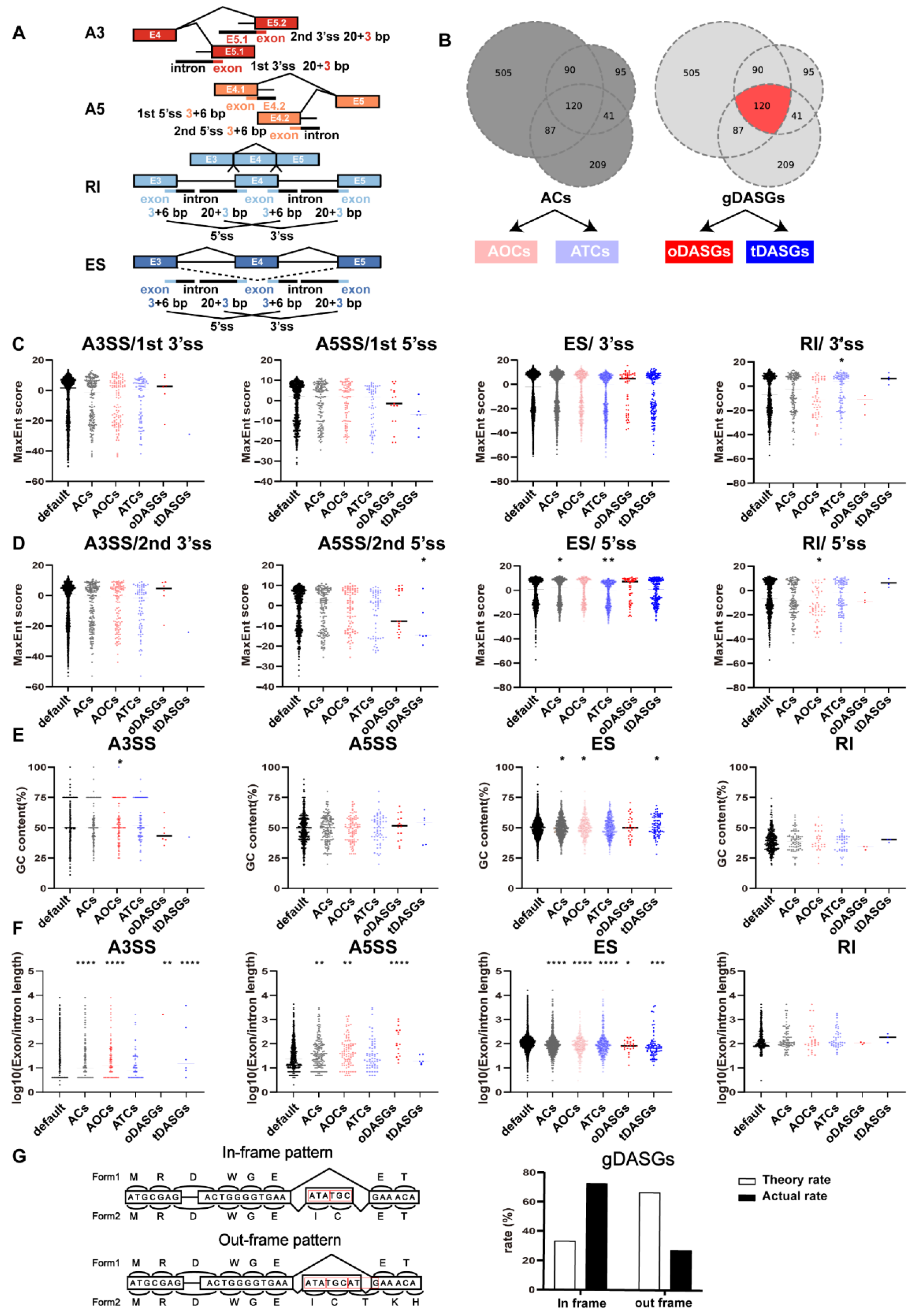

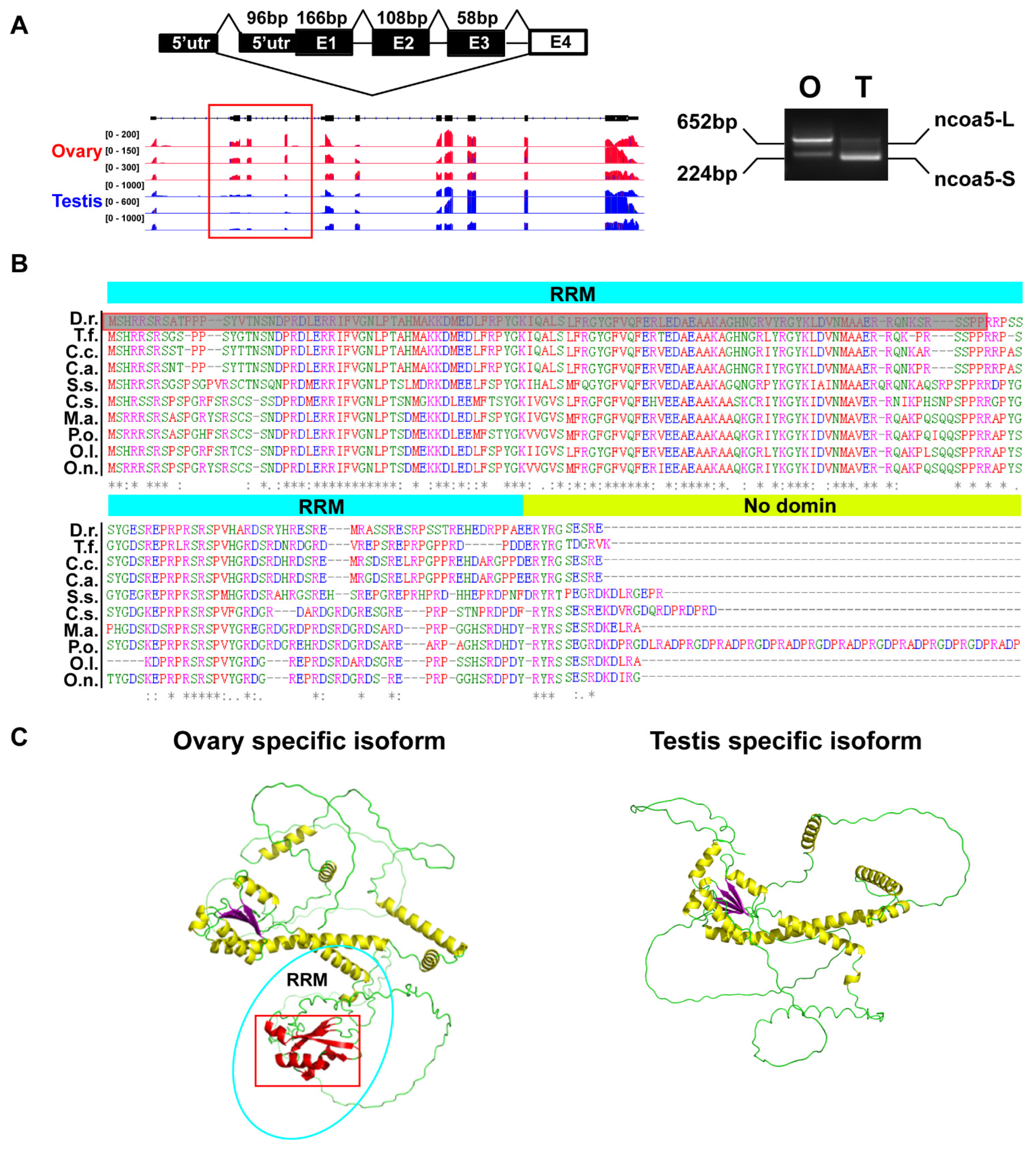
| Name of Primer (RT-PCR) | Sequence (5′ to 3′ Direction) |
|---|---|
| Cenpe-F | GACCGAAGTCAACTCACCCA |
| Cenpe-R | ACTGTAGTACTGACGCGCTG |
| kif2c-F | CACCCCTATTCCGACACCAA |
| kif2c-R | GAAGATGCCGAGACCACAGG |
| mapre1a-F | AGCTTGTGAAGGGCAAGTTTC |
| mapre1a-R | GTTGCCGCAGGAGATGTTTTT |
| ncoa5-F | CGCACTTCCGCACAGGATTA |
| ncoa5-R | CTCTCGACTTTCACGGTGGT |
| tpx2-F | AGACAAGAGCCGACAAGCTC |
| tpx2-R | GCCTTTAGTCGGACACTGCT |
| wdr62-F | GTTTCCGCAGTGCTGCTTGTC |
| wdr62-R | TCCACGGAGTTGCTTTGGTT |
Publisher’s Note: MDPI stays neutral with regard to jurisdictional claims in published maps and institutional affiliations. |
© 2022 by the authors. Licensee MDPI, Basel, Switzerland. This article is an open access article distributed under the terms and conditions of the Creative Commons Attribution (CC BY) license (https://creativecommons.org/licenses/by/4.0/).
Share and Cite
Lin, X.; Liu, F.; Meng, K.; Liu, H.; Zhao, Y.; Chen, Y.; Hu, W.; Luo, D. Comprehensive Transcriptome Analysis Reveals Sex-Specific Alternative Splicing Events in Zebrafish Gonads. Life 2022, 12, 1441. https://doi.org/10.3390/life12091441
Lin X, Liu F, Meng K, Liu H, Zhao Y, Chen Y, Hu W, Luo D. Comprehensive Transcriptome Analysis Reveals Sex-Specific Alternative Splicing Events in Zebrafish Gonads. Life. 2022; 12(9):1441. https://doi.org/10.3390/life12091441
Chicago/Turabian StyleLin, Xing, Fei Liu, Kaifeng Meng, Hairong Liu, Yuanli Zhao, Yuanyuan Chen, Wei Hu, and Daji Luo. 2022. "Comprehensive Transcriptome Analysis Reveals Sex-Specific Alternative Splicing Events in Zebrafish Gonads" Life 12, no. 9: 1441. https://doi.org/10.3390/life12091441
APA StyleLin, X., Liu, F., Meng, K., Liu, H., Zhao, Y., Chen, Y., Hu, W., & Luo, D. (2022). Comprehensive Transcriptome Analysis Reveals Sex-Specific Alternative Splicing Events in Zebrafish Gonads. Life, 12(9), 1441. https://doi.org/10.3390/life12091441







